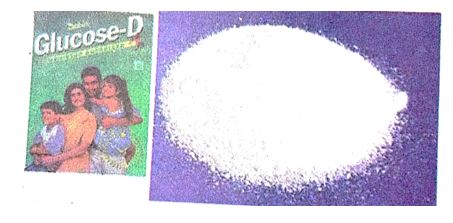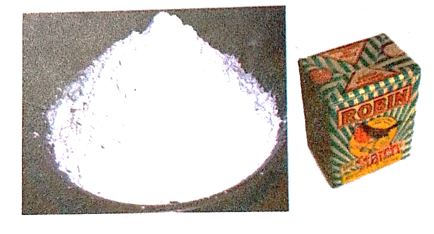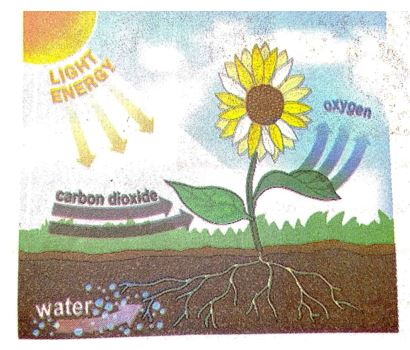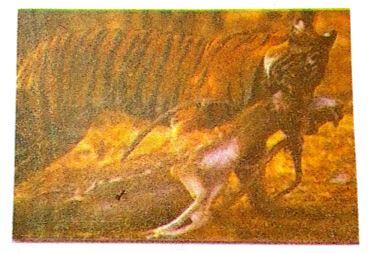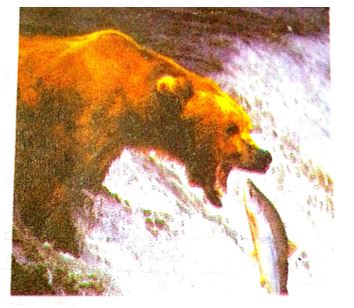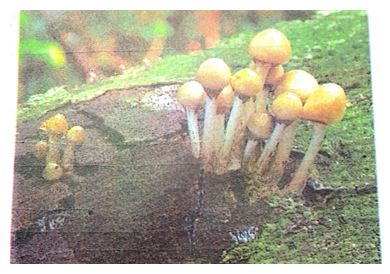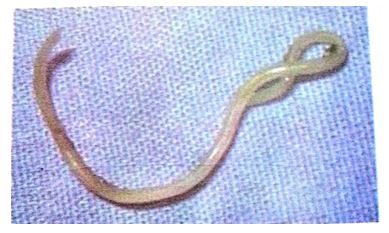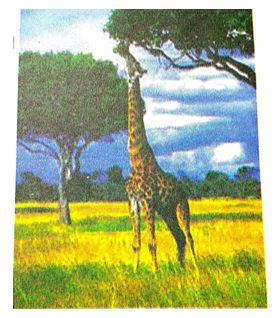Food is an organic substance. The simplest food is glucose. It is also called simple sugar. A more complex food is starch. Starch is made from glucose. The general name of substances like glucose (sugar) starch. and starch is ‘carbohydrates’. Carbohydrates are the most common foods for getting energy.
This is glucose powder. Glucose is the simplest food. It is very easily absorbed by our body.
This is starch powder. Starch is a complex food. food. Most of our common foods like wheat, rice and potatoes contain a lot of starch.
Fats and proteins are also foods. (A wider definition of food, however, also includes mineral salts, vitamins and water which are essential for the normal growth and development of an organism). The process of taking in food (consuming food) and utilising it is called nutrition. It is a process in which food is obtained in order to utilise it to provide energy for performing various metabolic activities of the organism. Actually, the term ‘nutrition’ comes from the word ‘nutrient’. A nutrient is an organic or inorganic substance required for the maintenance of life and survival of a living organism. In most simple terms, a nutrient can be said to be a particular type of food. A nutrient can be defined as a substance which an organism obtains from its surroundings and uses it as a source of energy or for the biosynthesis of its body constituents (like tissues and organs). For example, carbohydrates and fats are the nutrients which are used by an organism mainly as a source of energy whereas proteins and mineral salts are nutrients used by an organism for the biosynthesis of its body constituents like skin, blood, etc.
The food taken in by an organism contains a large number of nutrients like carbohydrates, fats, proteins, minerals, vitamins and water, etc. We can now say that : Nutrition is a process of intake of nutrients (like carbohydrates, fats, proteins, minerals, vitamins and water) by an organism as well as the utilisation of these nutrients by the organism. We will now describe the various ways of procuring food (or obtaining food) by the different organisms. In other words, we will now describe the different modes of nutrition of the various organisms.
Modes of Nutrition
Contents
Modes of nutrition means methods of procuring food or obtaining food by an organism. All the organisms do not obtain their food in the same way. Different organisms have different methods of procuring food or obtaining food. In other words, organisms differ in their modes of nutrition. Depending on the mode (or method) of obtaining food, all the organisms can be classified into two groups: autotrophic and heterotrophic. Thus : There are mainly two modes of nutrition :
1. Autotrophic, and
2. Heterotrophic.
We will now discuss the autotrophic mode of nutrition and the heterotrophic mode of nutrition in detail, one by one
1. Autotrophic Mode of Nutrition
The word ‘auto’ means ‘self’ and ‘trophe’ means ‘nutrition’. Thus, autotrophic means ‘self nutrition’. In autotrophic nutrition, the organism makes (or synthesizes) its own food from the inorganic raw materials like carbon dioxide and water present in the surroundings by using the sunlight energy. We can now say that : Autotrophic nutrition is that mode of nutrition in which an organism makes (or synthesizes) its own food from the simple inorganic materials like carbon dioxide and water present in the surroundings (with the help of sunlight energy). Please note that food is an organic material (like glucose, etc.). This means that, in autotrophic nutrition, organic material (food) is made (or synthesized) from inorganic materials like carbon dioxide and water by utilizing the sunlight energy.
The green plants have autotrophic mode of nutrition. The green plants make their own food by combining carbon dioxide from air and water from ground in the presence of sunlight energy. This process is called photosynthesis.
Corn is a food. This corn cob has been made by corn plants by the process of photosynthesis.
Carrots are a food. These carrots have been made by carrot plants by the process of photosynthesis.
The green plants have an autotrophic mode of nutrition. The autotrophic bacteria also obtain their food by the autotrophic mode of nutrition (though most bacteria are not autotrophic). The organisms having autotrophic mode of nutrition are called autotrophic organisms or just autotrophs.
Those organisms which can make their own food from carbon dioxide and water are called autotrophs. Carbon dioxide and water are inorganic substances. So, we can also say that: Those organisms which can make their own food from the inorganic substances present in the environment, are called autotrophs. All the green plants are autotrophs (because they can make their own food from inorganic substances like carbon dioxide and water present in the environment). Non-green plants are, however, not autotrophs. Certain bacteria called ‘autotrophic bacteria’ are also autotrophs.
The autotrophic organisms (or autotrophs) contain the green pigment called chlorophyll which is capable of trapping sunlight energy. This trapped sunlight energy is utilised by the autotrophs to make food by combining inorganic materials like carbon dioxide and water present in the environment by the process of photosynthesis. Thus, autotrophs make their own food by photosynthesis. So, autotrophs are the producers of food. The food produced by autotrophs (green plants) is also used by human beings and many, many other animals.
2. Heterotrophic Mode of Nutrition
The word ‘heteros’ means ‘others’ and ‘trophe’ refers to ‘nutrition’. Thus, ‘heterotrophic’ means ‘nutrition obtained from others’. In heterotrophic nutrition, the organism cannot make (or synthesize) its own food from the inorganic raw materials like carbon dioxide and water, and uses the food made by autotrophic organisms directly or indirectly. We can now say that: Heterotrophic nutrition is that mode of nutrition in which an organism cannot make (or synthesize) its own food from simple inorganic materials like carbon dioxide and water, and depends on other organisms for its food. A heterotrophic organism is a consumer which derives its nutrition from other organisms. That is, a heterotrophic organism has to eat other organisms for its nutrition. All the animals have a heterotrophic mode of nutrition. Most bacteria and fungi also have heterotrophic mode of nutrition. The organisms having heterotrophic mode of nutrition are called heterotrophic organisms or just heterotrophs.
Deer eating plant leaves as food
Tiger eating deer as food
Brown bear about to eat fish as food
Deer, tiger and bear all have heterotrophic mode of nutrition
Those organisms which cannot make their own food from inorganic substances like carbon dioxide and water, and depend on other organisms for their food are called heterotrophs. All the animals are heterotrophs (because they cannot make food from inorganic substances like carbon dioxide and water and obtain their food from other plants or animals.). Thus, man, dog, cat, deer, tiger, bear, lion, cow, etc., are all heterotrophs. The non-green plants (like yeast) are also heterotrophs. Heterotrophs depend on autotrophs and other heterotrophs for their food. In other words, animals are heterotrophs which depend on plants or other animals for their food.
From the above discussion we conclude that green plants make their own food. Non-green plants and animals cannot make their own food. They obtain food from plants and other animals. We will now discuss the various types of the heterotrophic mode of nutrition.
Types of Heterotrophic Nutrition
A heterotrophic organism (or heterotroph) can obtain its food from other organisms in three ways. So, the heterotrophic mode of nutrition is of three types:
1. Saprotrophic nutrition,
2. Parasitic nutrition, and
3. Holozoic nutrition.
We will now discuss the three types of heterotrophic nutrition in detail, one by one. Let us start with the saprotrophic nutrition.
1. Saprotrophic Nutrition (or Saprophytic Nutrition)
Saprotrophic nutrition is that nutrition in which an organism obtains its food from decaying organic matter of dead plants, dead animals and rotten bread, etc. ‘Sapro’ means ‘rotten’, so a saprotrophic organism draws its food from rotting wood of dead and decaying trees, rotten leaves, dead animals and household wastes like rotten bread, etc. The organisms having saprotrophic mode of nutrition are called saprophytes. We can now say that : Saprophytes are the organisms which obtain their food from dead plants (like rotten leaves), dead and decaying animal bodies, and other decaying organic matter (like rotten bread). Fungi (like bread moulds, mushrooms, yeast), and many bacteria are saprophytes.
Mushroom (fungus) has saprophytic mode of nutrition. This picture shows mushrooms obtaining their food body from the rotting wood of a dead tree.
We know that fungi and bacteria are a kind of plants. So, we can also say that saprophytes are the plants which feed on dead and decaying organic matter. The saprophytes break down the complex organic molecules present in dead and decaying matter and convert them into simpler substances outside their body. These simpler substances are then absorbed by saprophytes their as their food. Please note that saprotrophic nutrition is also known as saprophytic nutrition.
2. Parasitic Nutrition
The parasitic nutrition is that nutrition in which an organism derives its food from the body of another living organism (called its host) without killing it. The organism which obtains the food is called a ‘parasite’, and the organism from whose body food is obtained is called the ‘host’. We can now say that : A parasite is an organism (plant or animal) which feeds on another living organism called its host. A parasite receives its food from the host but gives no benefit to the host in return. A parasite usually harms the host. The host may be a plant or an animal. Most of the diseases which affect mankind, his domestic animals like (dogs and cattle) and his crops are caused by parasites.
Roundworm has a parasitic mode of nutrition. Roundworm is a common intestinal parasite of man. Roundworms remain free in the intestine of infected man (host) and obtain their food from him.
Parasitic mode of nutrition is observed in several fungi, bacteria, a few plants like Cuscuta (amarbel) and some animals like Plasmodium and roundworms. Thus, the micro-organism ‘Plasmodium’ (which causes malaria disease) is a parasite. Roundworm which causes diseases in man and domestic animals (like dogs and cattle) is also a parasite. Roundworms live inside the body of man and his domestic animals. Several fungi and bacteria, and plants like Cuscuta (amarbel) are also parasites. Some other examples of parasites are ticks, lice, leeches and tapeworms.
3. Holozoic Nutrition
‘Holozoic nutrition’ means ‘feeding on solid food’ (which may be a plant product or an animal product). Most of the animals (including human beings) take the solid food into their body by the process of ingestion. The ingested food is then digested (broken down) into simpler substances which are then absorbed into the cells of the body. And the undigested and unabsorbed waste materials are egested (thrown out) of the body. We can now say that: The holozoic nutrition is that nutrition in which an organism takes the complex organic food materials into its body by the process of ingestion, the ingested food is digested and then absorbed into the body cells of the organism. The undigested and unabsorbed part of the food is thrown out of the body of the organism by the process of egestion.
Giraffe has a holozoic mode of nutrition. This picture shows a giraffe eating the leaves from a tree.
The human beings and most of the animals have a holozoic mode of nutrition. In other words, man, cat, dog, cattle, deer, tiger, lion, bear, giraffe, frog, fish and Amoeba, etc., have the holozoic mode of nutrition.
You can write your questions and suggestions to us in the comment box given below.
Thank you

